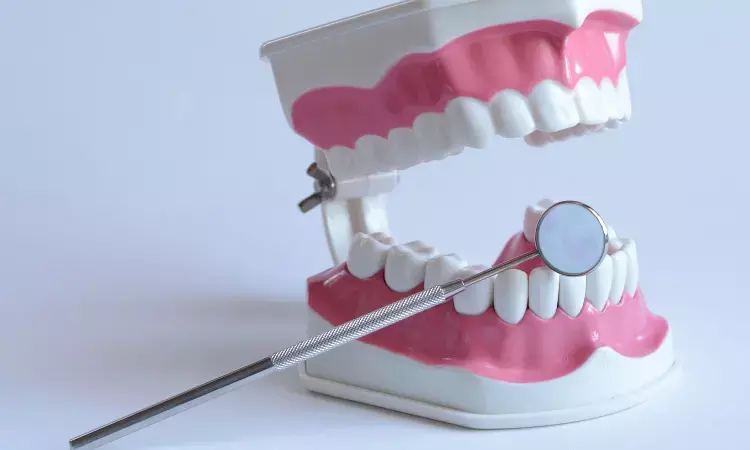- Home
- Medical news & Guidelines
- Anesthesiology
- Cardiology and CTVS
- Critical Care
- Dentistry
- Dermatology
- Diabetes and Endocrinology
- ENT
- Gastroenterology
- Medicine
- Nephrology
- Neurology
- Obstretics-Gynaecology
- Oncology
- Ophthalmology
- Orthopaedics
- Pediatrics-Neonatology
- Psychiatry
- Pulmonology
- Radiology
- Surgery
- Urology
- Laboratory Medicine
- Diet
- Nursing
- Paramedical
- Physiotherapy
- Health news
- Fact Check
- Bone Health Fact Check
- Brain Health Fact Check
- Cancer Related Fact Check
- Child Care Fact Check
- Dental and oral health fact check
- Diabetes and metabolic health fact check
- Diet and Nutrition Fact Check
- Eye and ENT Care Fact Check
- Fitness fact check
- Gut health fact check
- Heart health fact check
- Kidney health fact check
- Medical education fact check
- Men's health fact check
- Respiratory fact check
- Skin and hair care fact check
- Vaccine and Immunization fact check
- Women's health fact check
- AYUSH
- State News
- Andaman and Nicobar Islands
- Andhra Pradesh
- Arunachal Pradesh
- Assam
- Bihar
- Chandigarh
- Chattisgarh
- Dadra and Nagar Haveli
- Daman and Diu
- Delhi
- Goa
- Gujarat
- Haryana
- Himachal Pradesh
- Jammu & Kashmir
- Jharkhand
- Karnataka
- Kerala
- Ladakh
- Lakshadweep
- Madhya Pradesh
- Maharashtra
- Manipur
- Meghalaya
- Mizoram
- Nagaland
- Odisha
- Puducherry
- Punjab
- Rajasthan
- Sikkim
- Tamil Nadu
- Telangana
- Tripura
- Uttar Pradesh
- Uttrakhand
- West Bengal
- Medical Education
- Industry
New dental material may help reduce sensitivity of teeth in case of abrasion of enamel

Scientists have perfected hydroxyapatite, a material for mineralizing bones and teeth. By adding a complex of amino acids to hydroxyapatite, they were able to form a dental coating that replicates the composition and microstructure of natural enamel. Improved composition of the material repeats the features of the surface of the tooth at the molecular and structural level, and in terms of strength surpasses the natural tissue.
The new method of dental restoration can be used to reduce the sensitivity of teeth in case of abrasion of enamel or to restore it after erosion or improper diet. The study and experimental results are published in Results in Engineering.
"Tooth enamel has a protective function, but unfortunately, its integrity can be destroyed by, for example, abrasion, erosion or microfractures. If the surface of the tissue is not repaired in time, the enamel lesion will affect the dentin and then the pulp of the tooth. Therefore, it is necessary to restore the enamel surface to a healthy level or build up additional layers on the surface if it has become very thin. We have created a biomimetic (i.e., mimicking natural) mineralized layer whose nanocrystals replicate the ordering of apatite nanocrystals of tooth enamel.
We also found out that the designed layer of hydroxyapatite has increased nanohardness that exceeds that of native enamel," says Pavel Seredin, Leading Specialist at UrFU Center "Nanomaterials and Nanotechnologies", Head of the Department of Solid State Physics and Nanostructures at Voronezh State University.
Hydroxyapatite is a compound that is a major component of human bones and teeth. Scientists selected a complex of polyfunctional organic and polar amino acids, including, for example, lysine, arginine, and histidine, which are important for the formation and repair of bone and muscle structures.
The chosen amino acids made it possible to obtain hydroxyapatite, which is morphologically completely similar to apatite (the main component of tissues) of dental enamel. The researchers also described the conditions of the environment in which the processes of binding of hydroxyapatite to the dental tissue should occur. Only if these conditions are met it is possible to fully reproduce the structure of natural enamel.
"Traditionally in dentistry, composite restorative materials are used in enamel restoration. To increase the bonding efficiency of enamel and composite, the restoration technique involves acid etching of the enamel beforehand. The etching products left behind may not always have a positive effect on the bonding of enamel and synthetic materials.
To reproduce the enamel layers with biomimetic techniques, we neutralized the media and removed the etching products using calcium alkali. In this way we improved the binding of the new hydroxyapatite layers," explains Pavel Seredin.
The formation of a mineralized layer with properties resembling those of natural hard tissue was confirmed by field emission electron and atomic force microscopy as well as by chemical imaging of surface areas using Raman microspectroscopy.
The study was conducted on healthy teeth to eliminate the influence of extraneous factors on the resulting layer and to be able to compare the results with healthy teeth. Next, the researchers will tackle the challenge of repairing larger defects, which can be of varying nature from the initial stages of caries to cracks and volumetric fractures.
The joint research was conducted by scientists from the Research and Education Center "Nanomaterials and Nanotechnologies" of Ural Federal University, Voronezh State University, Voronezh State Medical University, Al-Azhar University, and the National Research Center (Egypt).
Reference:
Pavel Seredin, Dmitry Goloshchapov, Anna Emelyanova, Nikita Buylov, Vladimir Kashkarov, Anatoly Lukin, Yuri Ippolitov, Tatiana Khmelevskaia, Iman A. Mahdy, Manal A. Mahdy, Engineering of biomimetic mineralized layer formed on the surface of natural dental enamel, Results in Engineering, https://doi.org/10.1016/j.rineng.2022.100583.
Dr Kamal Kant Kohli-MBBS, DTCD- a chest specialist with more than 30 years of practice and a flair for writing clinical articles, Dr Kamal Kant Kohli joined Medical Dialogues as a Chief Editor of Medical News. Besides writing articles, as an editor, he proofreads and verifies all the medical content published on Medical Dialogues including those coming from journals, studies,medical conferences,guidelines etc. Email: drkohli@medicaldialogues.in. Contact no. 011-43720751


